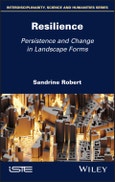This book combines spatio-temporalities, as described in archeogeography, with concepts that have been developed in the field of ecological resilience, such as panarchy and the adaptive cycle. Thus revived, the morphological analysis in this work considers landscapes as complex resilient adaptive systems.
The permanence observed in landscapes is no longer presented as the endurance of inherited forms, but as the result of a dynamic that is fed by this constant dialogue between persistence and change. Thus, resilience is here decisively on the side of dynamics rather than that of resistance.
Table of Contents
Acknowledgments xi
Introduction xiii
Part 1 Landscape: Continuity and Transformation 1
Introduction to Part 1 3
Chapter 1 Landscape: The Resistance of the Past? 5
1.1 The past in the present 5
1.1.1 Architectural and morphological persistences 5
1.1.2 Looking to the present to uncover the past: regressive history 7
1.1.3 The palimpsest as accumulation 9
1.2 Change, an eternal constant? 12
1.2.1 The diachronic approach 12
1.2.2 Connecting past and present 12
1.2.3 Drivers of change 15
1.2.4 Primary forms: a non-evolving landscape 18
1.2.5 The notion of decay 20
1.3 Reversible time 22
1.3.1 Resistance to change 22
1.3.2 The ancient plan as a work of art 23
1.3.3 The ancient plan as a societal project 24
1.3.4 Artificial versus natural forms 25
1.3.5 Conclusion 26
Chapter 2 Landscape: A Past… Surpassed? 29
2.1 A visual revolution 29
2.1.1 A new vision of landscape 30
2.1.2 The allure of a new vision 34
2.1.3 Are we moving toward erasure of the past? 37
2.2 A stratified landscape 38
2.2.1 Erasure in the palimpsest model 38
2.2.2 The fossil landscape 41
2.2.3 Buried landscapes 43
2.2.4 The stratified landscape 45
2.3 The synchronic view 50
2.3.1 Synchronizing forms and society 50
2.3.2 The negation of nature and the division of past from present 52
2.3.3 The break between past and present in methodology 53
2.3.4 The opposition of nature and culture 54
2.4 Conclusion 56
Chapter 3 Landscape: The Articulation of Past, Present and Future 59
3.1 The 1990s: a period of revival 59
3.1.1 Learning from the ground 59
3.1.2 Re-evaluating the nature/culture dichotomy 60
3.2 The inversion of time 63
3.2.1 Non-linear temporalities 63
3.2.2 Evolved forms versus decayed forms 65
3.2.3 From regressive analysis to compiled maps 66
3.3 Discovering new forms 69
3.3.1 River corridors 69
3.3.2 Formation networks 71
3.4 Landscape as a self-organized system 74
3.4.1 Self-organization and morphogenesis 74
3.4.2 Plot layouts and road and path networks as systems 75
3.5 Organizing principles in plot layout and road networks 80
3.5.1 Morphological principles: reproduction of parcel layouts and road networks 80
3.5.2 The role of morphogens 83
3.5.3 Morphostasis, transformission and resilience 88
3.5.4 The articulation of flow, ground footprint and shape 90
3.5.5 Asynchrony in flows, ground footprints and shapes: the importance of lag 95
3.6 Forms in a landscape: specific temporalities 101
3.6.1 New temporalities in archeogeography 102
3.6.2 Time as a spiral 105
3.7 Conclusion 107
Part 2 Resilience: A Tool for Understanding the Dialectics of Persistence and Change 109
Introduction to Part 2 111
Chapter 4 Ecological Resilience as a Systemic Property of Social-ecological Systems 115
4.1 The roots of resilience 115
4.2 Resilience versus stability: the dynamic role of perturbations 120
4.3 A dynamic approach to organization: the adaptive cycle 121
4.4 The panarchy model 124
4.4.1 Development of the model 124
4.4.2 Panarchy and social systems 129
4.5 Alternative attractors and transitions in complex systems 132
4.5.1 Multiple states 132
4.5.2 Alternative attractors and hysteresis 133
4.6 Conclusion 137
Chapter 5 Resilience and Spatial Systems 139
5.1 Pre-2005: the first appropriations of resilience in archeology and geography 140
5.1.1 Research in the English-speaking community 140
5.1.2 The French case: simultaneous adoption in archeology and geography 141
5.1.3 Geography: a limited adoption of the concept of resilience 149
5.1.4 Archeology: an adoption of resilience mediated by archeogeography 150
5.2 New developments and critical approaches after 2005 157
5.2.1 Adoption of the notion of resilience by public authorities and inflation of the term 157
5.2.2 The adoption of resilience in the geography of risks 161
5.2.3 A controversial appropriation of the notion of resilience 164
5.2.4 Assimilation with stability: engineering resilience 166
5.2.5 Resilience as a systemic property: a limited impact 168
5.3 Conclusion 172
Chapter 6 The Conceptual Framework of Ecological Resilience: A Long-term Approach 173
6.1 The conceptual framework of ecological resilience: points for discussion 173
6.2 The benefits of the long-term perspective 178
6.3 The cultural landscape: a field of heuristic experimentation 182
6.3.1 The contribution of cultural landscapes and land-use legacies 182
6.3.2 The role of spatial markers in social resilience 185
6.4 Transitions in settlement systems 188
6.5 Conclusion 191
Part 3 Synthesis: Landscape as a Resilient Social-ecological System 195
Introduction to Part 3 197
Chapter 7 Landscape: An Integrated System of Societies and Environments 201
Chapter 8 Landscape as a Complex Adaptive System 205
8.1 Landscape emergence as a system: key concepts 205
8.2 Maintenance and reproduction of landscapes as systems: key concepts 207
8.3 Temporalities of resilience in a landscape: key concepts 210
8.4 Transitions in landscapes: key concepts 216
8.5 Reorganization in a landscape: key concepts 218
8.6 The articulation between persistence and change in a landscape: key concepts 219
8.7 Temporalities of reorganization in landscape: key concepts 223
8.8 Conclusion: summary and directions for further investigation 224
Conclusion 229
References 233








